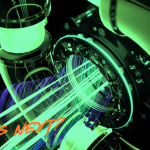Security and Surveillance at the Speed of Light
Powered by Optics Valley (Tucson, AZ) – Part of a $1T global market (by 2030)
Security today is about more than just locks and guards. Technology plays a central role in a world where threats can come from anywhere, physical spaces, the skies above, or the digital networks we rely on. At the heart of many of these technologies are optics and photonics. These fields deal with light and how we generate, control, and detect it. From night vision goggles to fiber optic cables that carry secure data, optics and photonics form the invisible shield protecting people, places, and information.
With this article, I hope to explore how optics and photonics are used in security, surveillance, and cybersecurity. I’ll do my best to simplify it, but you’ll see that the devices involved are often complex and powerful. Note that the number of devices and technologies is a subset of the current solutions and those under development.
Imaging and Vision Systems
The most apparent use of optics in security is imaging. Cameras are everywhere on city streets, in airports, in drones, and even in our pockets. But these aren’t just simple cameras anymore.
- Visible-light cameras use high-resolution CCD and CMOS sensors to capture clear images in daytime or well-lit areas.
- Infrared (IR) imaging systems detect heat rather than visible light. That makes them useful for spotting intruders at night or finding someone hiding in the dark. Police, firefighters, and the military all rely on thermal cameras.
- Low-light and night-vision devices work by amplifying tiny amounts of light. Image intensifiers and short-wave infrared (SWIR) optics can turn a nearly pitch-black field into something visible.
- Multispectral and hyperspectral imaging go beyond what the human eye can see. These systems break light into dozens or even hundreds of wavelengths. That way, security teams can tell if someone carries hidden materials, like explosives or drugs, based on how the materials reflect light.
- 360° panoramic lenses and fisheye optics provide wide coverage without blind spots. This can make a big difference in spotting unusual activity in crowded areas like airports or stadiums.
With these imaging technologies, security no longer depends on seeing what’s obvious; it means detecting what’s hidden.
Lidar and Laser Systems
Light Detection and Ranging, or lidar, uses lasers to map out environments in 3D. Initially developed for geology and self-driving cars, lidar is now applied to security.
- Perimeter surveillance lidar can accurately track movement along fences or borders.
- Coherent Doppler lidar measures the Doppler shift in reflected light to detect movement patterns, like distinguishing between a person walking and an animal wandering near a fence.
- Laser intrusion detection systems shoot a laser beam across a boundary. If the beam is interrupted, the system knows something has crossed the line.
- Laser dazzlers are a more active security tool. These non-lethal devices send out bright beams that can disorient or temporarily disable optical sensors or even human intruders.
Lidar and laser systems allow security forces to “paint” environments with light, turning empty spaces into watchful zones.
Optical Fiber Security
Most people think of fiber optic cables as sending internet or phone data. But fibers are also robust security sensors.
- Distributed Acoustic Sensing (DAS) turns standard fiber optic cables into vibration detectors. By analyzing how light scatters inside the cable, DAS can sense footsteps, vehicles, or even digging activity along a buried cable. This makes it helpful in monitoring long stretches of pipelines, borders, or railroads.
- Fiber Bragg Gratings (FBGs) are tiny structures built into fibers that reflect specific wavelengths of light. When pressure or strain changes the fiber, the reflected light shifts like a digital tripwire for fences, doors, or floors.
- Perimeter intrusion detection systems use buried optical fibers to detect movement in the soil. They’re sensitive enough to know if a person, vehicle, or tunneling activity is nearby.
Organizations can double their security without extra infrastructure by using fibers for communication and detection.
Biometric and Identity Verification
Security isn’t just about protecting spaces; it’s also about ensuring the right people have access. Optics and photonics make advanced biometric identification possible.
- Iris and retina scanning rely on near-infrared (NIR) imaging. No two eyes are the same, and these systems can accurately verify identities.
- Facial recognition has become common in airports and smartphones. Many systems use structured light or time-of-flight (ToF) sensors to measure depth, preventing people from fooling them with photos.
- Fingerprint scanning often uses optical imaging, where light bounces off the ridges and valleys of a print.
- Vein recognition works by shining near-infrared light under the skin to map out unique vein patterns.
These biometric systems often combine with AI to create faster, more reliable identification.
Spectroscopy and Chemical Detection
Security also means detecting dangerous substances. Photonics offers tools for chemical detection in real time.
- Raman spectroscopy uses lasers to analyze the vibration of molecules. This can identify explosives, narcotics, or hazardous chemicals.
- Infrared spectroscopy works by measuring how molecules absorb IR light. Different substances have unique absorption patterns, like fingerprints for chemicals.
- Laser-induced breakdown spectroscopy (LIBS) uses a powerful laser pulse to vaporize a tiny part of a material, then studies the light emitted to identify its elements.
- Ultraviolet (UV) fluorescence detection can reveal counterfeit IDs, hidden inks, or tampered banknotes.
These tools allow border control, customs agents, and first responders to quickly and precisely identify threats.
Quantum Photonics for Security
The future of secure communication may lie in quantum photonics.
- Quantum key distribution (QKD) uses single photons to send encryption keys. If someone tries to eavesdrop, the photons change state, and the intrusion is instantly detected.
- Single-photon detectors enable both QKD and ultra-sensitive surveillance in very low-light conditions.
- Quantum random number generation (QRNG) ensures truly unpredictable encryption keys essential for secure systems.
Although still developing, quantum photonics is expected to revolutionize surveillance and cybersecurity.
Cybersecurity Through Photonics
Cybersecurity is not just about software; it also depends on how data is transmitted. Since most of the world’s internet traffic already flows through fiber optics, photonics directly protects it.
- Optical encryption scrambles data at the light level, making it harder for hackers to intercept.
- Optical packet inspection uses photonic switches to monitor internet traffic at ultra-high speeds, detecting unusual patterns faster than electronic systems can.
- Side-channel monitoring can detect physical intrusions, like attempts to tap into fiber optic cables.
- Photonic neural networks are being developed for intrusion detection, where light-based processors can analyze massive data flows for anomalies at terabit speeds.
In short, optics isn’t only about “seeing” threats, it’s about protecting the digital backbone of modern life.
Drones, Satellites, and Remote Surveillance
Security increasingly depends on mobile and remote platforms.
- Drone-mounted imaging and lidar provide real-time surveillance of large areas, from military bases to disaster zones.
- Underwater photonics uses blue and green lasers to penetrate water for port and subsea monitoring.
- Satellite imaging combines multispectral optics with synthetic aperture radar (SAR) to track activity from space, which is essential for border security and national defense.
With these tools, security doesn’t stop at the fence line; it extends to the skies, oceans, and beyond.
Anti-Counterfeiting and Authentication
Protecting goods and documents is another area where optics shines.
- Holographic seals and diffractive optical elements (DOEs) make it nearly impossible to forge passports, ID cards, and currency.
- Nanophotonic tags are invisible, unclonable markers embedded in high-value items to prove authenticity.
- Laser markings add tamper-resistant identifiers to military equipment, electronics, or medical devices.
These optical features fight fraud and keep supply chains secure.
AI, Big Data, and Optical Security
All these systems, from hyperspectral cameras to fiber DAS networks, generate enormous amounts of data. AI and machine learning are now paired with optics to make sense of everything.
- AI-enhanced recognition can spot unusual behavior in IR or hyperspectral video streams.
- Predictive analytics can analyze data from distributed photonic sensors to detect suspicious patterns.
- Fusion systems combine physical surveillance (like cameras and lidar) with cybersecurity monitoring, offering a complete security picture.
Ultimately, optics and photonics are not just about light but about making sense of the world at high speed across multiple domains.
Conclusion
Security and surveillance have entered a new age. Cameras no longer just record, they analyze. Fiber optic cables don’t just carry data; they sense intruders. Lasers don’t just measure, they protect perimeters. And photons themselves may soon become the building blocks of unbreakable encryption.
From night-vision goggles to quantum communication systems, optics and photonics technologies are creating a future where light itself guards our borders, cities, and digital networks. The world is more connected and more vulnerable than ever. Thanks to photonics, we have powerful tools to make it safer. This is just the beginning.








